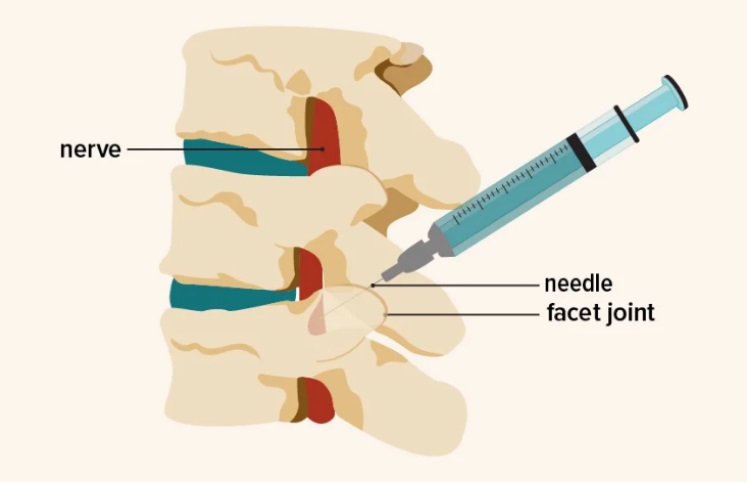Information
A facet joint injection is a medical procedure that involves the injection of pain-relieving and anti-inflammatory medications into the facet joints, situated at the posterior part of the spine between each vertebra. Pain in these joints can be triggered by wear and tear from years of use or traumatic injuries.
This minimally invasive procedure aims to alleviate pain, and many individuals find relief for an extended period after receiving the injection. The risk of complications is low, making it a relatively safe option.

Facet joint injections incorporate medications, including steroids that contribute to inflammation reduction, along with the inclusion of lidocaine or other pain relievers to provide relief.
Facet joint pain can arise from various potential causes, including:
- Osteoarthritis
- Joint instability
- Traumatic injury
- Impingement (excess pressure) of joint tissue
- Inflammation of joint lining
Types
Facet joint injections entail the precise insertion of a thin needle into a facet joint, guided by imaging techniques like fluoroscopy (live x-ray) or ultrasound.
Intra-articular injection
This injection is given into the intra-articular space (the space within the facet joint capsule and the purpose is Diagnostic and Treatment.
Medial branch nerve block
This injection is given near the medial branch nerves of the suspected facet joint and the purpose is Primarily diagnostic.
Side Effects
Potential side effects of facet joint injections are typically minor, and while the procedure is generally safe, there are some associated risks.
Common side effects include:
- Swelling
- Pain around the injection site
- Temporary increase in back pain
Occasionally, anti-inflammatory drugs used in the injection may lead to side effects such as:
- Warmth
- Fluid retention
- Weight gain
- Increased appetite
- Mood swings
- Irritability
- Anxiety
- Insomnia
Severe complications are rare. It's possible for facet injections to temporarily worsen pain due to swelling at the injection site. However, this discomfort typically subsides as the medication takes effect. Applying an ice pack to the sore area for up to 20 minutes at a time may help alleviate any discomfort.
Procedure
The facet joint injection procedure is a minimally invasive process that typically lasts under 30 minutes, conducted on an outpatient basis, allowing you to return home on the same day. While conscious during the procedure, you may be offered sedation through an IV in your hand or arm.
Here's an overview of what you can anticipate:
- Positioned face down on a table, you'll be connected to monitoring machines to track your vitals.
- The injection site will be sterilized, and a drape will be used to prevent contamination.
- Your surgeon will administer a local anesthetic to numb the area using a needle.
- Guided by either fluoroscopy (real-time X-ray) or a CT scan, the surgeon will insert the facet joint injection through your skin into the joint, potentially using a contrast dye for accuracy.
- The steroid and pain reliever will be injected into the joint.
- Upon completion, the needle will be removed, and pressure will be applied to prevent bleeding. Stitches are typically not necessary.


